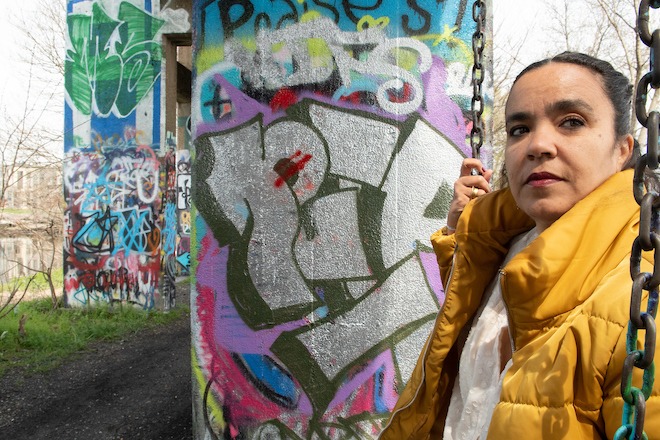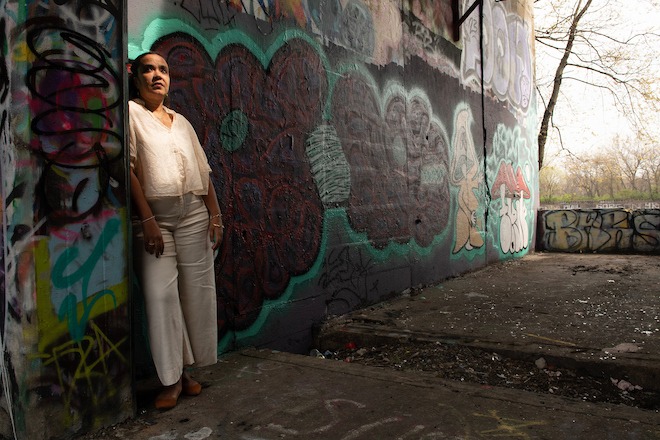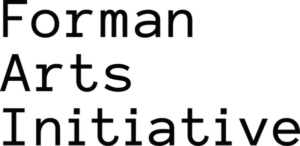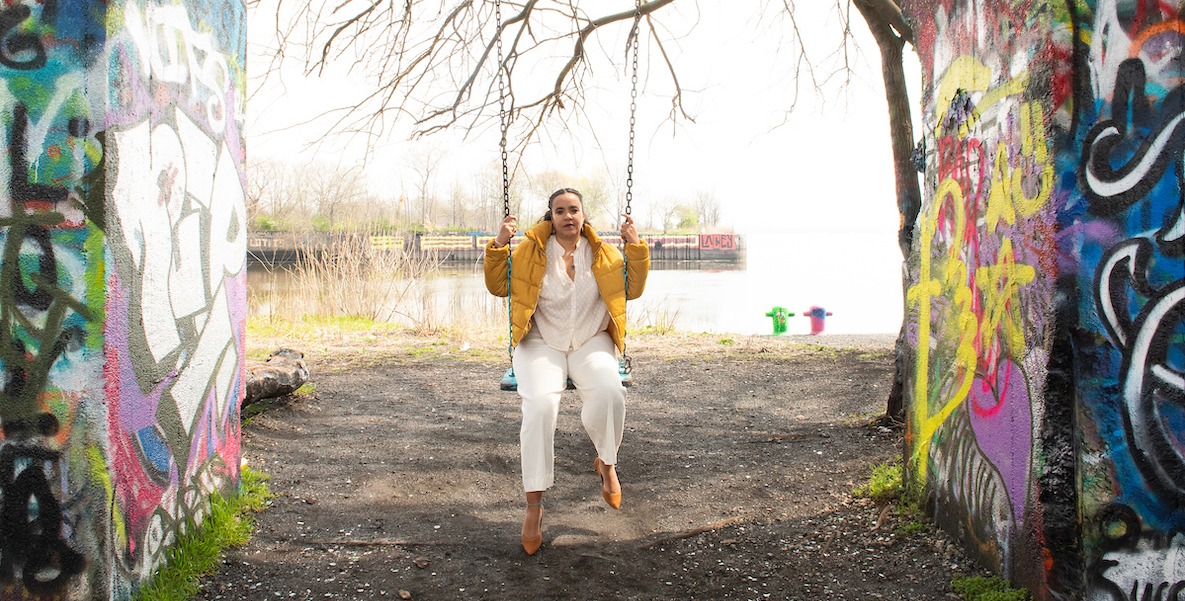When Michael Forman and Jennifer Rice set about looking for a leader to take the helm of their four-year-old Forman Arts Initiative (FAI), they had a choice: They could go the usual route, hiring an administrator with a background in art history or curation to shepherd of their vast collection of paintings, sculptures and video into Philly’s newest museum.
Or, they could hire someone like Adjoa Jones de Almeida, a veteran of arts and education collectives in Brooklyn and Brazil, who sees art not as a staid collection of objects, but as a means for enacting social change. It was an obvious choice.
“Our priorities were what Adjoa brings,” says Rice, the founding chair of the FAI board (and a Citizen Board Member). “The way Michael and I think about FAI is that art is the tool we’re using for all the things we want to accomplish: community engagement, education, workforce development and social impact. It’s like what Kenny Holdsman is doing at Philadelphia Youth Basketball — except with art, not basketball.”

With Jones de Almeida, FAI is starting where many arts organizations are playing catch up: with a deliberate and deep focus on community and bringing diverse artists and audiences together. What that will mean in practice is part of what Jones de Almeida — who spent the last 10 years with the Brooklyn Museum — is here for.
One major project: a brick and mortar arts campus on North American Street, for the couple’s vast collection of contemporary art — including a growing number of works by local artists, women and people of color — as well as programming, funding, storytelling, education and public art making.
Jones De Almeida, who is half African American and half Brazilian, grew up in Brazil and New York City. For 10 years, she was a founder and member of the “truly horizontal collective” Sister to Sister, a mentorship program for young Black and Brown women based on the legacy of Freedom Schools. She spent another seven years in a northeastern Brazil fishing village, working with a collective around environmental justice. In both cases, she approached the work through the lens of the arts, creative expression and dialogue.
“I have focused on trying to really understand what happens when young people, and adults, are inspired and motivated to make huge leaps in terms of thinking about their own trajectory, and what they want to change, and how that is activated through an artistic experience,” she says. “So after those seven years in Brazil, I was like, Okay, I have found what the secret sauce is. It’s the arts — however you want to define that.”
Jones De Almeida took the helm of FAI in March. I caught up with her shortly after she moved to East Kensington, walking distance from FAI’s proposed new campus.
This interview has been condensed and edited for clarity.
You have a very unusual trajectory — from two decades working in collectives in Brooklyn and Brazil, to a job at the Brooklyn Museum. That’s a huge leap.
You’re absolutely right — the Brooklyn Museum is commemorating its 200th anniversary this year. It’s an encyclopedic institution, right? It has all the baggage and the history of encyclopedic institutions and all the beauty of it, too.
The Brooklyn Museum was the first to start this model, that now everyone has, where the whole museum is open until 11pm on First Saturdays. It becomes a big party essentially, with DJs, and a dance party and all the things are free, and very inclusive. Even though it’s a super traditional museum, it’s unlike any other in that most people that visit the museum identify as BIPOC. You go to a First Saturday, most people there are Black and Brown, primarily Black. So I was really interested in what it means to hold so many physical objects, and at the same time try to be radically inclusive.
I came in as an educator in the education division, and eventually became Deputy Director for Learning and Social Impact, which gave me an opportunity to develop a “social action framework” for the museum, really attempting to reimagine how we think about encyclopedic art institutions. What is possible in terms of how institutions with that kind of that caliber and magnitude engage in dialogue, and share power with local communities?
How did the connection happen between you and the Formans?
From what I’ve been told, Jen and Michael talked to a lot of museum leaders and other people — like Thelma Golden of the Studio Museum in Harlem — about different models, trying to understand what’s already here, what’s not here, what would be additive, what is missing. And one of the things that kept coming up is that you really should center someone coming from an education and community engagement background, rather than only considering people coming from an art historical background or curatorial background. Obviously, if it weren’t for that, I might not have been considered.
The idea of radical collaboration, I think, is something that the Formans are very interested in. They are a really interesting pair; they obviously have a lot of resources, a lot of wealth, a lot of privilege. But they also are deeply interested and committed to Philadelphia, and have an interest in learning who community leaders are, and in how they might be most impactful supporting communities facing all kinds of struggles. There is something to this idea of deep collaboration that kind of puts aside ego and personal interests to try to really understand how multiple minds, multiple approaches, maybe even out-of-the-box experimental approaches, might help to expand the impact of FAI.
You could have an art historian/curatorial person who runs everything and then hires a community-oriented educator. Or you could flip it. So you can bring in somebody to do that curatorial part.
That’s right. And it sort of shapes the primary vision of the initiative.
What is that vision?
One of the things that I find most inspiring about what’s already happening at FAI is one of its three core programs — public works, which, to me, is very telling. In the framing of this program lies the kernel that I really want to dig out and nurture, this idea of placing artists with city agencies.
It’s this idea of what some might call the radical imagination. There’s a writer [Amy Whitaker] I’m kind of mildly obsessed with who published this book called Art Thinking: How to Carve Out Creative Space in a World of Schedules, Budgets, and Bosses. It’s activating art as a verb, and what can happen when you approach really challenging social problems from an imaginative lens. What that opens up is surprising, because it pushes us to reconsider, to reframe, to humanize processes that over time have become really, in some cases, dehumanized.
There’s so much that can be done to really strengthen that program so that it’s not just about a cool artists residency that happens over the course of X amount of months, with the artists just being accountable to their own artistic vision, but about going through a process of understanding the core challenges this agency is facing. What are the struggles in terms of really serving the public that they’re there to serve?

So is the idea to help the departments reimagine how they can serve the people of Philadelphia?
Yeah — that’s not to say that we’re the technical experts. We’re recognizing that there is a kind of magic that happens when you connect and bring together stakeholders with very different approaches. It’s a real transformative moment for the artists as well, who may have only thought about accountability in relation to their own artistic practice, and all of a sudden, are being asked to really understand a systemic issue and what might be missing, or how an artistic vision could help serve not just for the benefit of their artistic practice.
Can you give an example?
I wasn’t here for the first round of this, but artists [from FAI] worked with SEPTA and, as I understand it, two things happened: There were a series of stories, including those highlighting SEPTA workers and their trajectories in life and how they perceive their work. And then there was an installation, and the stories all over SEPTA buses and trains.
So I’m interested to understand how does that shift the experience of those who use SEPTA? What has it been like to all of a sudden understand the life trajectory of these workers? Does it change their experience as people depending on SEPTA? That’s a small example, but I think there’s something there to think more broadly about.
The first round was with SEPTA. This round is in partnership with the Office of Immigrant Affairs.
You mentioned the three arms of FAI. One is public art. One is FAI Stories [The Citizen’s Art for Change series]. And the other is a brick-and-mortar campus on North American Street. Will that include a museum, with art on the walls?
We’re really interested in reimagining what an art space that holds a collection can look like, can feel like. I think that the word “museum” has a lot of baggage that actual museums are wrestling with in this moment — there are certain immediate associations about who belongs, whom it’s for, and museums are trying to address that. I don’t really know why an institution that doesn’t look or feel at all like a museum would voluntarily latch on to the idea of being a museum.
Up to now, FAI has been primarily known as a grant making organization, supporting artists and this residency. That’s really needed. But as we start to think about what it will mean to be to be a brick-and-mortar organization based in a specific community, there’s a lot of exciting possibilities that come with that — and also a lot of potential red flags if we don’t take the time needed to really understand who the key community voices and community organizations are in that landscape, who have been around for decades, even during times in the city when there wasn’t as much interest in opening “cultural corridors.”
FAI as an institution is deeply interested in collaboration, and imaginative thinking, and centering the power of art as a verb, as an approach to dealing with social issues and social struggles. It’s going to be important to slow down enough to implement a process that makes space for deep listening, and for deep dialogue with existing communities, so we make sure that we’re coming in and proposing programs and strategies that are additive, that help others expand their expand their impact, in addition to allowing us to expand ours.
What does “art as a verb” mean?
Sometimes people in this day and age, especially when you’re thinking about museums, have this idea of white walls and art as a framed painting that you put on a wall. And of course, that is art.
But there is also a way in which art is really an approach, a way of understanding, a way of investigating the world, where you’re wrestling with internal forces — like things that you want to create and birth into the world — and the external constraints of materials and systems, and things that are interacting with you. And that kind of wrestling, playing, experimenting between an interior realm and an exterior realm is another way of thinking about art. And when you think about it from that perspective, art is a verb — it’s open and exploratory and invites in multiple senses. And it really leans on and strengthens this thing we call the imagination.
What is often frustrating about how people frame the idea of arts, is that it’s seen as a privilege, as something that’s nice to have, if you can — rather than understanding that, especially in this day and age that’s still emerging from a global pandemic, facing so much violence and war as the only solutions to social conflict, that there’s a need to strengthen our ability as humans to imagine possibilities that we don’t see. You only do that when you have practiced and when you have been nurtured to lean into your imagination. So in that sense, too, art is a verb; it is an ability to allow people to break free from the confines of what they think is possible.
It’s also organically linked to the idea of social justice and social change. Because it’s like you’re activating your imagination, your ability to manifest something that doesn’t exist, to create a new path that is more human, that is more peaceful, that is more, you know, connected.
That’s beautiful. I can’t wait to see what this all looks like.

This story is part of a partnership between The Philadelphia Citizen and Forman Arts Initiative to highlight creatives in every neighborhood in Philadelphia. It will run on both The Citizen and FAI’s websites.
![]() MORE FROM OUR ART FOR CHANGE SERIES
MORE FROM OUR ART FOR CHANGE SERIES



